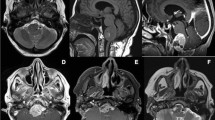Abstract
A 60-year-old man with progressive gait ataxia and mild pyramidal signs showed at MRI a pontine lesion with post-contrast enhancement in the left middle cerebellar peduncle. Diagnosis of Erdheim-Chester disease (ECD), a rare non-Langerhans cell histiocytosis, was suggested, further supported by a previously diagnosed retroperitoneal fibrosis. X-ray films demonstrated characteristic bilateral and symmetric osteosclerosis of the long bones of the lower limbs, which at radionuclide studies exhibited a marked increase in technetium-99 uptake. A cerebral 18FDG-PET showed a relevant pontine uptake of the tracer. Re-evaluation of a past retroperitoneal biopsy showed an intense CD68+, CD1a-, and S100-infiltrate of histiocytes with foamy cytoplasm, thus confirming the diagnosis. ECD should be regarded as a rare cause of adult-onset sporadic ataxia, especially when pontine lesions and extraneurological manifestations are present.
Sommario
Descriviamo il caso di un uomo di 60 anni con quadro neurologico progressivo caratterizzato principalmente da atassia della marcia e modesti segni piramidali, in cui la risonanza magnetica dell’encefalo dimostrava una lesione pontina con un’area di impregnazione del mezzo di contrasto nel peduncolo cerebellare medio sinistro. Il sospetto di malattia di Erdheim-Chester, una rara istiocitosi non-Langerhans, era ulteriormente avvalorato dalla presenza di una fibrosi retroperitoneale diagnosticata in precedenza. Le indagini radiografiche hanno documentato la presenza delle tipiche alterazioni osteosclerotiche bilaterali e simmetriche delle ossa lunghe degli arti inferiori che alla scintigrafia ossea con tecnezio-99 hanno dimostrato una intensa captazione del tracciante, particolarmente a livello delle ginocchia. La PET cerebrale con 18FDG ha rivelato una intensa captazione del tracciante a livello pontino. La rivalutazione di una biopsia retroperitoneale eseguita in passato ha confermato la diagnosi di malattia di Erdheim-Chester sulla base del riscontro di un marcato infiltrato di istiociti con citoplasma schiumoso CD68 positivi, ma CD1a ed S100 negativi. La malattia di Erdheim-Chester deve essere considerata tra le cause di atassia sporadica ad esordio tardivo, soprattutto quando sono presenti lesioni pontine e manifestazioni extraneurologiche associate.
Similar content being viewed by others
References
Veyssier-Belot C, Cacoub P, Caparros-Lefebvre D et al (1996) Erdheim-Chester disease. Clinical and radiologic characteristics of 59 cases. Medicine (Baltimore) 75:157–169
Lachenal F, Cotton F, Desmurs-Clavel H et al (2006) Neurological manifestations and neuroradiological presentation of Erdheim-Chester disease: report of 6 cases and systematic review of the literature. J Neurol 253:1267–1277
Brodkin CL, Wszolek ZK (2006) Neurologic presentation of Erdheim-Chester disease. Neurol Neurochir Pol 40:397–403
Mascalchi M, Nencini P, Nistri M et al (2002) Failure of radiation therapy for brain involvement in Erdheim Chester disease. J Neurooncol 59:169–172
Adle-Biassette H, Chetritt J, Bergemer-Fouquet AM et al (1997) Pathology of the central nervous system in Chester-Erdheim disease: report of three cases. J Neuropathol Exp Neurol 56:1207–1216
Wright RA, Hermann RC, Parisi JE (1999) Neurological manifestations of Erdheim-Chester disease. J Neurol Neurosurg Psychiatry 66:72–75
Fukazawa T, Tsukishima E, Sasaki H et al (1995) Erdheim-Chester disease and slowly progressive cerebellar dysfunction. J Neurol Neurosurg Psychiatry 58:238–240
Evidente VG, Adler CH, Giannini C et al (1998) Erdheim-Chester disease with extensive intraaxial brain stem lesions presenting as a progressive cerebellar syndrome. Mov Disord 13:576–581
Vencio EF, Jenkins RB, Schiller JL et al (2007) Clonal cytogenetic abnormalities in Erdheim-Chester disease. Am J Surg Pathol 31:319–321
Stoppacciaro A, Ferrarini M, Salmaggi C et al (2006) Immunohistochemical evidence of a cytokine and chemokine network in three patients with Erdheim-Chester disease: implications for pathogenesis. Arthritis Rheum 54:4018–4022
Bohlega S, Alwatban J, Tulbah A et al (1997) Cerebral manifestation of Erdheim-Chester disease: clinical and radiologic findings. Neurology 49:1702–1705
Pereira Neto CC, Roman C, Johnson M et al (2004) Positron emission tomography/computed tomography of a rare xanthogranulomatous process: Erdheim-Chester disease. Mol Imaging Biol 6:63–67
Girszyn N, Arnaud L, Villain D et al (2007) Usefulness of combined positron emission tomography and computed tomography imaging in Erdheim-Chester disease. Rev Med Interne 28:770–774
Namwongprom S, Nunez R, Kim EE et al (2007) Tc-99m MDP bone scintigraphy and positron emission tomography/computed tomography (PET/CT) imaging in Erdheim-Chester disease. Clin Nucl Med 32:35–38
Lin E (2007) FDG PET/CT for biopsy guidance in Erdheim-Chester disease. Clin Nucl Med 32:860–861
Martinez R (1995) Erdheim-Chester disease: MR of intraaxial and extraaxial brain stem lesions. Am J Neuroradiol 16:1787–1790
Author information
Authors and Affiliations
Corresponding author
Rights and permissions
About this article
Cite this article
Salsano, E., Savoiardo, M., Nappini, S. et al. Late-onset sporadic ataxia, pontine lesion, and retroperitoneal fibrosis: a case of Erdheim-Chester disease. Neurol Sci 29, 263–267 (2008). https://doi.org/10.1007/s10072-008-0978-2
Received:
Accepted:
Published:
Issue Date:
DOI: https://doi.org/10.1007/s10072-008-0978-2




